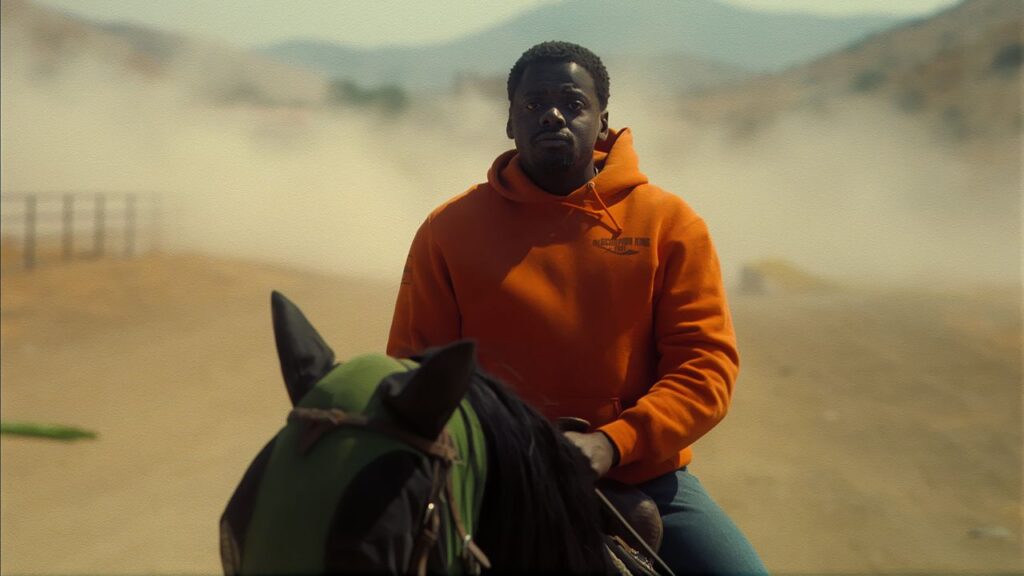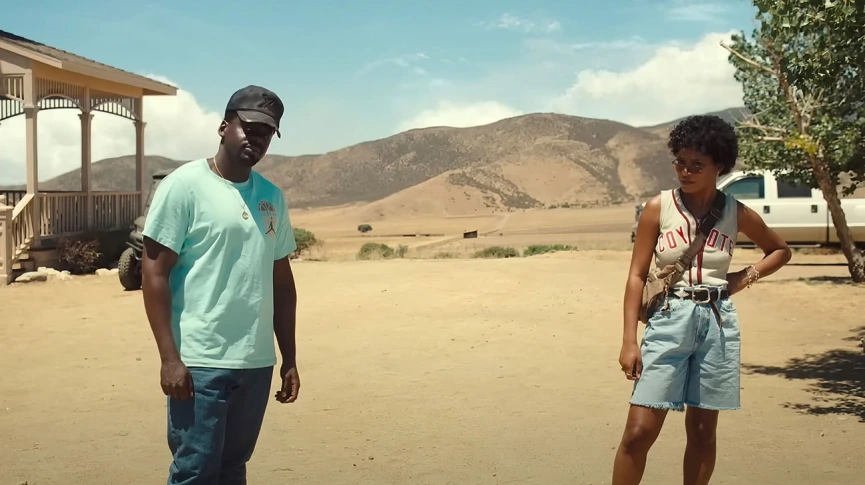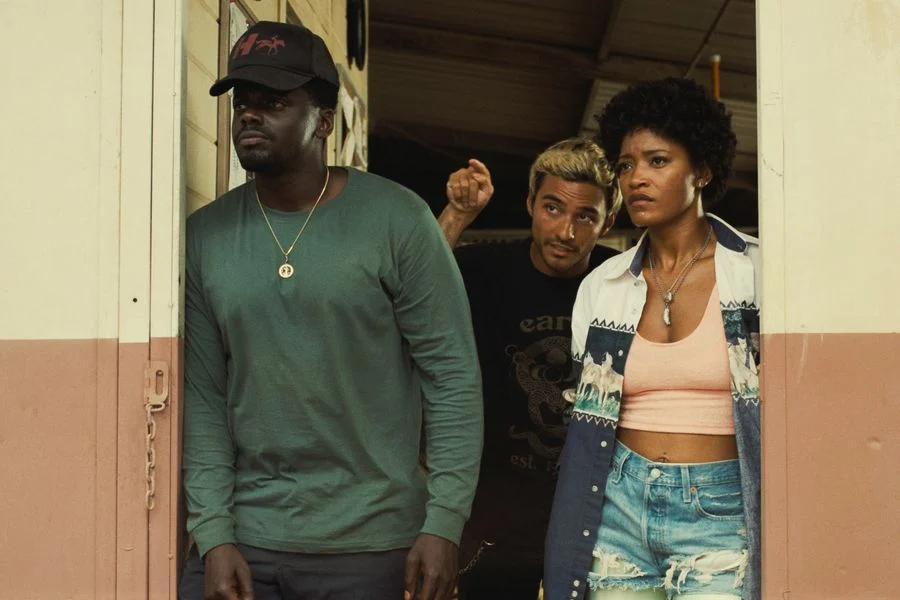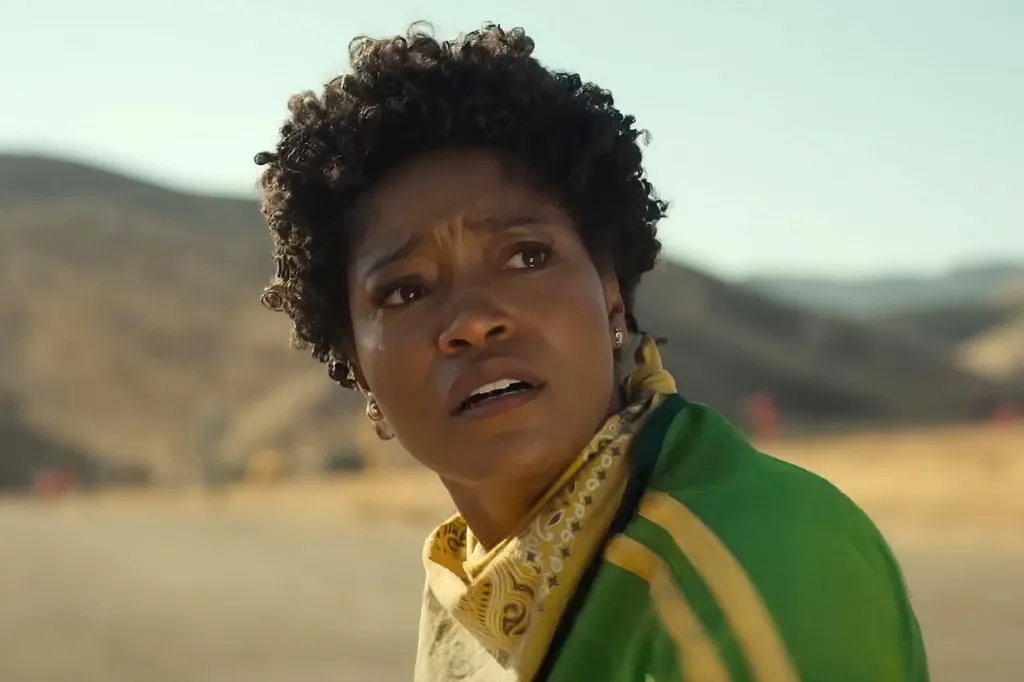
Throughout Nope, the eye-popping and brain-tingling third feature from Jordan Peele, title cards bearing the name of an animal interrupt the proceedings, as if to divide the movie into discrete, enigmatic chapters. The headings typically refer to various horses (Lucky, Ghost, etc.) who are owned and trained by the main characters, while the final section opens with a nickname assigned to the mysterious, malevolent force that looms in the sky above their house. At the rough midpoint, however, the elaborate scheming and the interplanetary hijinks are put on pause, and the film rewinds several decades to the set of a multi-camera sitcom, where the titular attraction is a chimpanzee called Gordy.
What follows is one of the most spellbinding set pieces I’ve seen on screen in quite some time. Combining sturdy cinematic building blocks—witty production design, precise framing, a painstakingly purposeful harmony of image and sound—Peele concocts a sequence that accumulates furious momentum yet is also achingly, exquisitely still. We glimpse the events, a ghastly display of chaos and carnage, from the perspective of a small boy named Jupe (Jacob Kim), who we already know will age into the commercially savvy proprietor of a Western-style theme park, where he will be played with sly confidence by Steven Yeun. Yet in the moment, that foreknowledge provides little comfort, and as the young Jupe hides under a table, paralyzed with fright, you are less likely to sympathize with him than embody him—frozen in horror, yet helpless to look away.
What, you may ask yourself, does this insular episode of primal violence have to do with an expansive science-fiction movie about carnivorous extraterrestrials? I confess to pondering the same question. I don’t mean this as an exasperated reprimand (“God, what is the point of this?”), but as a recognition of Nope’s puzzles and complexities (“What is the point?”). Peele has delivered a picture that both frustrates and tantalizes, cloaking its themes and obscuring its ideas while also bristling with energy and piling on the genre goodies. In some ways, it resembles the shadowy entity that camouflages itself inside a suspiciously stationary cloud hovering over the heroes’ ranch—difficult to fathom, yet undeniably there.

The aforementioned Gordy sequence is so good, it’s tempting to wish that the entirety of Nope proceeded on a similarly small scale—as a brisk and taut creature feature that discards intricacy and ambition in favor of pure, white-knuckle suspense. Suffice it to say, that isn’t the movie Peele made. He has instead crafted a sprawling, somewhat unwieldy epic, one that is alternately vexing, exhilarating, and just plain weird. Comparisons to M. Night Shyamalan’s Signs are both apt and erroneous; whereas that alien-invasion thriller was resolutely spare, this one is bursting with subplots and crawling with incidents.
What they share, however—aside from mildly similar premises—is an appreciation of cinema as a playground for directorial showmanship. Every modern science-fiction auteur must suffer comparisons to Steven Spielberg (remember this?), an association Peele brazenly invites by featuring numerous shots of characters gazing upward, their faces a mixture of wonder and terror. He also routinely supplies memorable images (the cinematographer is the great Hoyte Van Hoytema, on loan from Christopher Nolan), whether it’s the classical sight of blood dripping down a rain-streaked window or the more novel vista of a desert dotted with battery-powered sky dancers—a rainbow spectrum swaying in the wind.

The leisurely opening act that sets the stage for these subsequent bits of visual audacity is rather deliberately paced, though it has its own magnetizing appeal, in part because it’s rooted in movies themselves. Our protagonists, the Haywoods—a pair of faintly estranged, ultimately devoted siblings named O.J. (Daniel Kaluuya) and Emerald, or “Em” (a terrific Keke Palmer)—are minor players in the entertainment industry, running a faltering horse-wrangling business that they inherited from their late father (Keith David), who is inexplicably killed by flying debris during an early scene. (The shot of a catatonic David slumping over his steed is yet another haunting, archetypal image.) Yet their filmic lineage runs deeper: According to Em, she and her brother are descendants of the jockey who rode the stallion in “The Horse in Motion,” the famous photographic series that’s widely credited as inventing the motion picture. Even the title carries a meta dimension, referring to the Haywoods’ repeated refusals to investigate creepy phenomena, as distinct from the stereotypically dumb slasher-film victims who unwittingly (and witlessly) tiptoe toward their own deaths.
And the main plot of Nope, in which the Haywoods grow to suspect (based on a series of random power outages, perplexing weather patterns, and bizarre equine behavior) that something extraterrestrial is lurking near their property, integrates durable cinematic tropes—the concept of people battling aliens is as old as the science-fiction genre itself—with the more modern trend of amateur content creation. Rather than flee their childhood home, O.J. and Em resolve to capture evidence of the supposed UFO on camera, hoping to sell the viral-ready footage for sizable profit. Of course, making movies requires a crew, so they recruit a venerable cinematographer (the always-welcome Michael Wincott), along with an electronics-store employee (Brandon Perea) whose persistent presence they initially suffer, then tolerate, then embrace. Meanwhile, nearby, the now-adult Jupe begins to pivot his old-timey attraction—which had leveraged his past fame and trauma (Yeun’s recollection of a Saturday Night Live sketch featuring Chris Kattan as Gordy is a miniature video essay on processing grief)—into a different kind of amusement, one that similarly capitalizes on the newfound celestial presence.

Essentially, all of the characters in Nope are artists. Wielding their intelligence, their instincts, and their craft, they hope to seduce the ticket-buying public with the promise of dazzling experiences and extraordinary spectacle. Remind you of anyone?
This notion—the intersection between art and commerce, between the noble goal of creating enduring literature and the selfish act of exploiting your circumstances for financial gain—is intriguing. I am not sure it’s anything more than that, or that Peele marshals his provocative thoughts into a cogent or explosive thesis. There are two possibilities: Either Nope is much smarter than I am, or it isn’t nearly as smart as it pretends to be. The former is admittedly more likely, but regardless, I absorbed the film more as a pleasingly messy assemblage of colliding ideas than a brilliantly woven masterpiece.
But even if the movie’s themes are less than mind-blowing, its execution is robustly entertaining. Though it courses with big-budget energy and exotic action, Nope retains a palpably human center, thanks largely to its lead actors, who complement one another perfectly. Kaluuya throttles down his natural intensity to a smoldering burn, and his steady restraint works in counterpoint to the sizzling vivacity of Palmer, whose preternatural charm represents the picture’s greatest discovery. O.J. and Em’s familial camaraderie is both realistic and charismatic; the moment when they engage in a sudden and repeated sideways high five is a delightfully choreographed burst of giddiness.

And for all its tension, Nope is deeply enjoyable, albeit in unusual ways. A disciple of the school of visual withholding (again, Spielberg), Peele doesn’t show his hand too early, preferring to let the suspense build and the anxiety thicken. As a result, several set pieces—a panicky scene on the ranch, a terrifying attack on a crowd—aren’t conventionally satisfying so much as unnervingly peculiar, bombarding you with strange sights and forcing you to adjust to incomprehensible surroundings. (The immersive sound design enhances this sensation, as do the fluid special effects.) The climax, though—which Peele wisely sets during broad daylight, allowing his demented vision to unfold with bright clarity—is pure adrenaline. Even if the ultimate villain can appear a little silly (at times it looks like a gigantic sombrero), it also takes shapes that seem to have never existed until now—a truly alien presence bent on annexing the earthly plane.
It is that sense of surreality that makes Nope such a worthy enterprise. Viewed from an unflattering perspective, it arguably lacks the punch of Peele’s prior productions; it is neither as politically bracing as Get Out nor as narratively gripping as Us. But it shares with those films a breathtaking quality of innovation—a riveting newness. Nope is a traditional alien-adventure movie that doubles as a never-before-seen species, and if its ideas don’t always synchronize with its events, it is nonetheless a triumph of invention—the work of a gifted artist whose cinematic imagination remains majestically out of this world.
Grade: B+
Jeremy Beck is the editor-in-chief of MovieManifesto. He watches more movies and television than he probably should.
